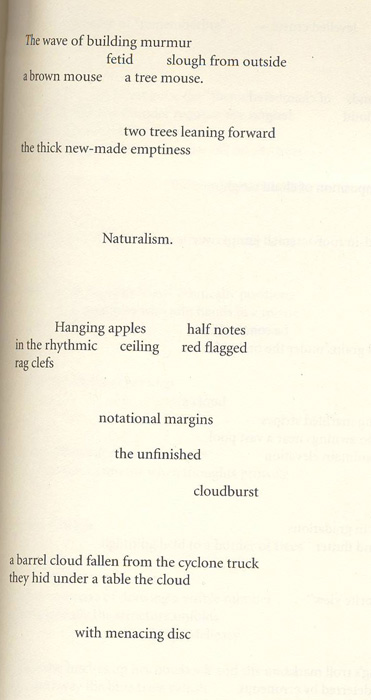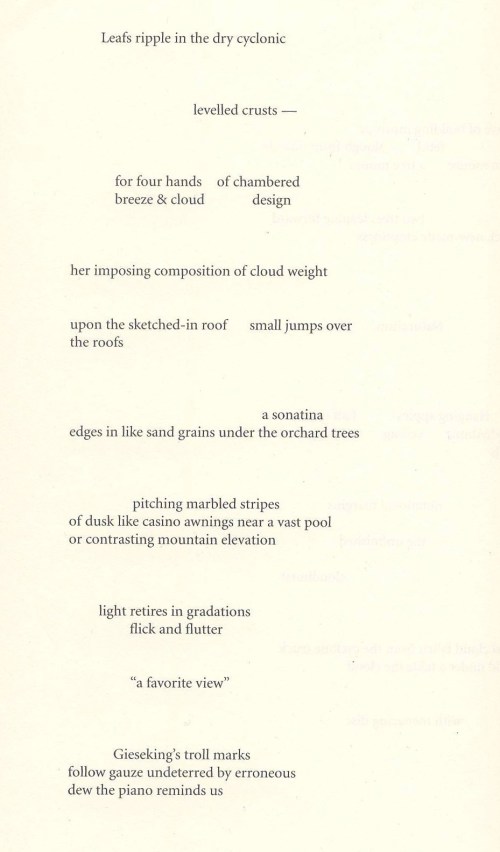Musicality




To dive right in:
The wave of building murmur
What is “building murmur”? A crescendo of indistinct, hushed voices in a wave gathering momentum? That interpretation would give the poem from the start a reflexive turn, an awareness of its own murmur of words building on themselves. And the juxtaposed sounds of the two words are pleasing: the multiple, concentrated consonants (“b-l-d-n-g”), including the two plosives (“b”and “d”), contrast with the repeated syllables in “murmur.” And a crescendo of a murmur is like a wave gaining momentum. The onomatopoeia of “murmur,” the soft nasal m’s and liquid r’s of which imitate the soft, low sounds that the word describes, suggests Guest’s concern with the connection between the sound of a word and its meaning. That’s a clue to what is to come.
The next line contrasts the increasing wave with a stagnant body of water:
fetid slough from outside
The alliteration of the fricatives “f” and “s” alternate with the plosives “t” and “d”—producing a rich interplay of sounds. Does the meaning of these words also come into play? A stagnant miasma of water might smell bad from an outside perspective, but what if one is on the inside? A fish whose home is a stinky swamp doesn’t think its home smells bad. A difficult poem might seem like a “fetid slough” but from the inside, it is possible to get past the murkiness of the water to appreciate the wealth of interweaving sounds and meanings.
Is the next line a non-sequitur?
a brown mouse a tree mouse.
I think it’s possible to appreciate the disjunctiveness of the leap from a stinky swamp to mice at the same time that we perceive some continuities and development of previous ideas. Here Guest continues her play of repetition (“mouse” and the repeated “ow” sound) as well as her theme of nature (wave, slough, mouse, tree). She also introduces the pair idea, things happening in twos, which the next line echoes:
two trees leaning forward
I like the tension in the image of the trees “leaning forward,” as if in hushed anticipation. Are they murmuring? Maybe that’s a hermeneutic stretch, but I like taking the cognitive leap. This line picks up an image from the previous line, “tree,” and recontextualizes it. That’s a kind of music – picking up a motif previously stated and presenting it as a variation.
And the next line develops the dichotomy between the wave (the poem) and the slough (the perceived impenetrability of the poem):
the thick new-made emptiness
“Thick” resonates with “slough”—I think of soupiness. And the idea of making something is echoed many times in “Musicality”: Guest is the poet, the maker (hearkening to the Greek root of “poet”) as well as the composer, creating—emptiness? Why emptiness, and why is it newly made? The next word helps, a sort of keystone on the page with a presence that sets it apart:
Naturalism
It’s capitalized, it’s centred on the page, and the other lines give it a wide berth—note the space that separates it from the lines above and below it. Its apartness gives it a monolithic quality, as though it were carved in stone: a rule, a prescription for language.
The literary movement of naturalism relied heavily on mimetic correspondences to produce a transparent texture of language that may be heavily descriptive but that aims to convey a precise image of reality, a window made of language from which to view not only colours and details but also the historical contingencies of human motivation, in its own way a valuable psychological contribution. Nonetheless, the characteristics of naturalism are generally antithetical to many of the concerns of high modernism and avant-gardism, which tends to de-center perception, knowledge, language, meaning, identity, and motivation.
So is naturalism the “thick new-made emptiness”? The lines and ideas in Guest’s poem are not isolated; they gain meaning in relation to other lines and words, so “naturalism’s” isolation is striking, daring us to associate the word itself with something else, to take naturalism not as the rule but as one idea among others, and as one entity in the poem that chameleon-like shifts its colours according to surrounding or juxtaposed ideas—and Guest does just this by bringing the category of naturalism into play with its surrounding words, allowing it to be changed. It is not simply naturalism changing language to its own tenets and beliefs about the function of language. Guest allows other words to colour naturalism itself.
Perhaps emptiness refers to the transparency of language in naturalism, the quality of sheerness that conveys us without much reflexivity from word to referent. But how can emptiness be thick? Guest implies that the lens of the medium of language is thick with its own inherent possibilities. This idea is consonant with Guest’s exploration of language as a kind of music.
In my previous post, I talked about the kind of music that Walter Pater might have been alluding to when he said that all art aspires to the condition of music: non-programmatic “absolute” or instrumental music that tends to create a self-referential world producing meaning from the “tonally moving forms” (Herzog 125) of its own medium. Musicality in poetry sidles away from a mimetic function of language towards a self-referential interplay of sounds and motifs, in a similar way that music does.
In the next three lines, we shift gears again—are do we?
Hanging apples half notes
in the rhythmic ceiling red flagged
rag clefs
“Hanging apples” is a good naturalistic image, but immediately Guest compares apples hanging on their stems with half notes, which also feature a round part with a stem:

This comparison brings together two major strands in the poem: nature (the natural) and music (the made). This shift again focuses our attention on the idea of language being not only a conduit to describe the world but also a path to its own world, its musicality. Thus the juxtaposition of apples and notes returns us to the idea of language (words, sounds, images) as music. In the second line, a ceiling is “rhythmic.” If we look up to see the hanging applies, we might see them against the ceiling of the sky, articulating that backdrop to produce rhythm, as if they were notes on a staff.
I want to give detailed attention to the phrases “red flagged” and “rag clef.” First, let’s consider the interplay of connotations and denotations of these words, in particular the semantic chiasmuses between the two phrases. Each phrase has musical significations. In musical notation, a flag is the little banner projecting from the stem of a note to indicate its duration: a single eighth note has one flag, and a sixteenth note has two. In the second phrase, a clef is a symbol that indicates the particular register of a staff: treble clef or bass clef, for instance. These are both symbols in musical notation. Also, “flag” resonates with “rag”: not only do the words rhyme, but also both indicate things made of fabric. And sonically, “red” echoes “rag.” Moreover, the related consonant sounds in “flagged” and “clef” are almost the exact reverse of each other:
f-l-g / c-l-f
In the simultaneity of all of these correspondences can be heard—for lack of a better analogy—a polyphonic interplay of motifs and sounds.
The medium of Guest’s musical language produces not a description of a place or person, not anything classifiable as strictly mimetic, not a building wave of description that prompts the readers to say (to quote Helen Vender) “Heavens, I recognize the place, I know it!” According to Vendler, the reader’s eureka moment resulting from the accumulation of descriptive language “is the effect every poet hopes for.” Oops, she forgot Barbara Guest, whose work instead displays a fascination with the possibilities of language itself. A composer might ask, what would happen if I have a flute echo this motif introduced by a violin? Guest asks, what would happen if I put these words and sounds in various contexts, producing motifs that repeat but that also express rich variation?
Here I’ll hit the pause button—I’ve gone on longer than I had intended for only nine lines. But this process for me is so rewarding. And it takes a slow, leisurely pace of reading and thinking to get to this level of detail. And I realize that my interpretation is very subjective—one person’s response to the poem. But for me these discoveries open up new dimensions of the poem, which is I go after in poetry. An acutely intelligent mind has placed these words on the page. The pleasures lie in wait, unrealized notes on a staff, for the reader-musician’s careful attention.
A Postscript
As I look over my analysis of “Musicality,” I can see that my close reading of the poem, with its complex overlapping of layers of experience, is much more detailed than I had anticipated. As soon as I start strolling instead of galloping through the woods, I start seeing and hearing so much more. And the deeper I probe into the microcosm of the poem, the more correspondences I start to find between the smaller scale and the larger scale.
This is starting to sound like structuralism—to use an analogy in music, the Schenkerian analysis that relies on the structural correspondences between the large-scale background harmonic movement (its skeletal tonal structure) and the small-scale foreground tonal movement. Inevitably, there emerged dogmatic Schenkerian music theorists who claimed that such analysis leads to the (one and only) inner truth of a musical composition.
As I analyzed “Musicality,” I realized that all I have done is to open one or two doors in a room that has many doors. Once you start believing in one musicality, you become something other than an interpreter; you become an arbiter of interpretations. As I tried to demonstrate in my previous post, musicality in poetry isn’t monolithic. And just as there’s more than one way to create a symphony of words, there’s more than one way to hear it.
I used to know a rather orthodox Shenkerian analyst. Sadly, the dogmatism of his belief in tonal structuralism precluded his appreciation of Western music written beyond a certain point in the nineteenth century when the increasing chromaticism turned its sound waves into a “fetid slough” in the ears of the theorist, who had been trained to hear only the exquisite harmonic and melodic structures he had built up from, say, a Mozart sonata. Wolf, Debussy and Webern were unintelligible to him because they were resistant to his surgeon’s tools.
Camille Martin
http://www.camillemartin.ca
Pingback: Musicality in Poetry « Rogue Embryo